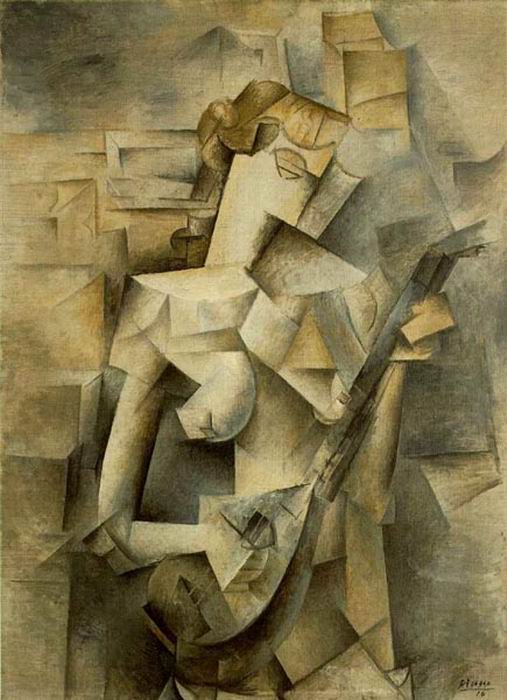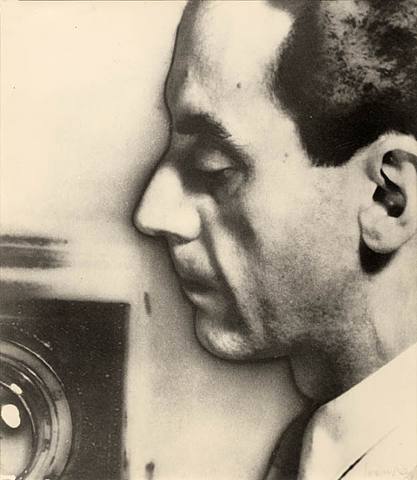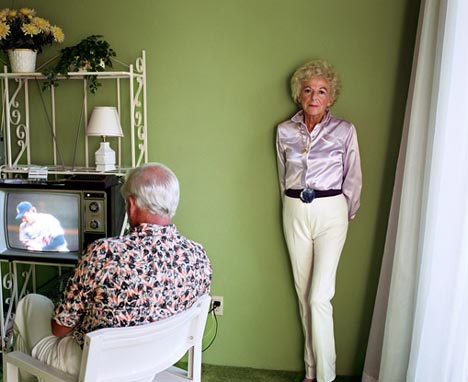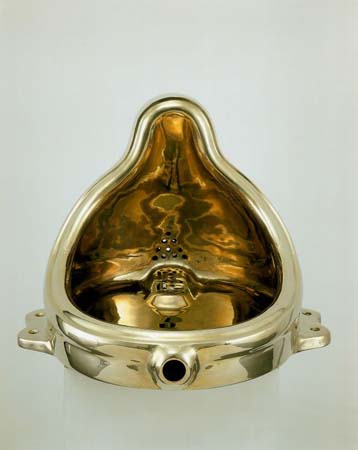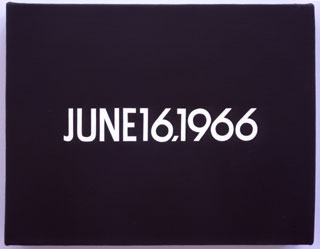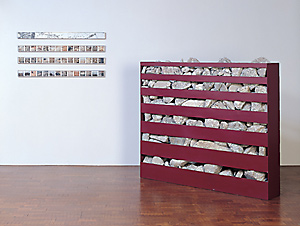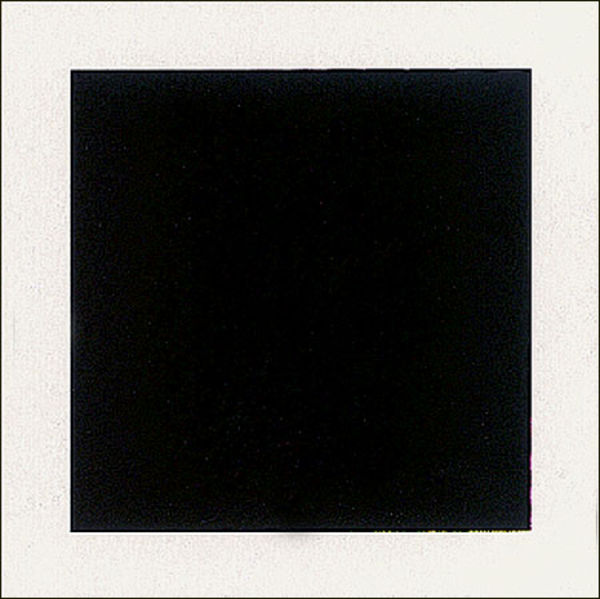"...[M]y notion of the public is functional. The word 'public' for me does not designate any particular people; it refers to a role played by people, or to a role into which people are thrust or forced by a give experience. And only those who are beyond experience should be exempt of belonging to the public. As to the 'plight'--here I mean simply the shock of discomfort, or the bewilderment or the anger or the boredom which some people always feel, and all people sometimes people, when confronted with an unfamiliar new style."
--Leo Steinberg, "Contemporary Art and the Plight of its Public"
"The onlooker who says his child could paint a Newman may be right, but Newman would have to be there to tell the child exactly what to do." --Clement Greenberg, "After Abstract Expressionism"
These two quotes might not seem directly related at first, but to me they sum up exactly the reasons why contemporary art will always be the most fascinating period of art history. Not necessarily because the content of post-modernism is somehow always better, but because of the precise relation between us as viewers and the art is different than with any other field. The shock, boredom, bewilderment of the first encounter with the new is precisely what gives it that special, differentiating quality. In Leo Steinberg's essay he talks about his first encounter with Jasper John's work, and how he was initially struck with the particular kind of bewilderment he describes as belonging to the public. What could it have possibly been like to see Johns' work or Rauschenberg's for the first time after years of abstract expressionism dominating the American art market? Similar to what it might have been like to see Matisse's Joy of Life for the first time after impressionism, his argument goes. What I loved about Steinberg's essay is that it gives a definition to the fascination I've had with contemporary art since I was first introduced to it in Anne Wagner's new media course as an undergraduate. I have had a number of conversations with people about why studying contemporary art is so different than modern or really any other period. They are almost like two different disciplines. This is not to say I haven't valued all the effort I've put into studying modern art lately--on the contrary, it is extremely necessary and useful in order to fully grasp the significance of contemporary changes and trends. But when the historical context of a work is your own historical context as well, the difference is huge. This is what I believe to be the cause of the plight of Steinberg's public. But like Steinbeg, I also believe this plight to be something positive. "Contemporary art is constantly inviting us to applaud the destruction of values which we still cherish, while the positive cause, for the sake of which the sacrifices are made, is rarely made clear. So that the sacrifices appear as acts of demolition, or of dismantling, without any motive--just as Courbet's work appeared to Baudelaire to be simply a revolutionary gesture for its own sake." I would modify this sentence slightly by saying that it applies to [GOOD] contemporary art. What could be better than seeing your values slashed to pieces by an art object, only to slowly come to terms with why those values need to be modified in order to move forward? We see this time and time again. I could think of dozens of examples that would further support Steinberg's argument. Michael Fried's Art and Objecthood essay for example, in which he dismisses minimalist art work as theatrical. That essay could be a case study of an art critic experiencing precisely what Steinberg discusses. Fried is the public, and minimalist art is the cause of his plight. The viewer described by Greenberg is another example of a public according to Steinberg. The distrust of contemporary art that frequently gets translated as "my kid could do that,"--that phrase contemporary (and even Modern) art enthusiasts must constantly battle--is another form of the public's plight in Steinbergian terms. How do you respond to that question? I usually start with "Well, that's how you know it must be good. Because despite that fact, here it is, on the Museum wall. It must have some serious historical and conceptual weight to end up here instead of on your refrigerator door."
Thursday, April 22, 2010
Wednesday, April 14, 2010
Assemblage--old and new

Raoul Hausmann, ABCD, 1923-1924
 Robert Rauschenberg, Charlene, 1954
Robert Rauschenberg, Charlene, 1954 Robert Rauschenberg, Monogram, 1955-59
Robert Rauschenberg, Monogram, 1955-59Rob Fischer, Mirrored Boat (Disappearing Boat), 1998 (source)
 Mark Dion, New England Digs Project, 2001
Mark Dion, New England Digs Project, 2001
 Mark Dion, New England Digs Project, 2001
Mark Dion, New England Digs Project, 2001
Rob Fischer, Mirrored House on Water, 2007 (source)
I've been looking through Art in America articles from the early 1960's, in order to see if the writers attempt to come to terms with the supposed transition between the modern and contemporary periods. In comparing Johns and Rauschenberg to the abstract expressionists (only since they came right before) it can appear to me as if their practices came out of nowhere--this is why the concept of transition interested me. But Tom Crow's text from Modern Art in the Common Culture reminded me that while the practices of these two artists may seem drastically different in response to abstract expressionism, they are making use of techniques that had been around since the European avant-garde--namely, assemblage and the recycling of mass-produced images. That is why they are called Neo-Dada after all.
My original question of "where did this come from" seems to be echoed in a lot of the articles I've read in Art in America. Within pages and pages of abstract expressionist paintings there are brief mentions of this new practice of assemblage attributed to Rauschenberg and Johns, citing their work from the mid-late 50's. They don't exactly seem to agree with Greenberg's final paragraph in "after abstract expressionism" but they do approach it as if it were something quite alien in my opinion. Some interesting concepts that I keep coming across are that "now art can be anything (now being 1960)," and that as of 1960 American art was "moving back towards order" which was also stated to be a reflection of the political climate and American sentiment. I see this as a possible starting point for a project that involves looking at the aftermath of the rise of the American art market with abstract expressionism and its relationship to the kind of anxiety Rauschenberg and Johns were creating. I think focusing on Rauschenberg's early work might be a way to do this, though I am hesitant to work on such a "big name." I would be interested in looking at his work in terms of his role in a transition, but this would just be the starting point.
This is brings me to the concept of assemblage and how it has changed over time. While it may have begun within the European avant-garde, it was taken to an entirely different level with pop art. Now, it might seem silly to even bring up the topic of assemblage, since, as was discussed in a previous post, "new media" art supposedly allows for anything. The newness of mixed-media has certainly expired (good, because I hate that word, its so vague). However, with this post I make the proposition that the specific lineage of assemblage art has in fact been carried on in the contemporary period within the category of green art. The very fact of recycling materials taking center stage in some artists' practices is an entirely new motivation for an old concept--that of assemblage. The "everyday object" now has a very urgent and specific message.
My original question of "where did this come from" seems to be echoed in a lot of the articles I've read in Art in America. Within pages and pages of abstract expressionist paintings there are brief mentions of this new practice of assemblage attributed to Rauschenberg and Johns, citing their work from the mid-late 50's. They don't exactly seem to agree with Greenberg's final paragraph in "after abstract expressionism" but they do approach it as if it were something quite alien in my opinion. Some interesting concepts that I keep coming across are that "now art can be anything (now being 1960)," and that as of 1960 American art was "moving back towards order" which was also stated to be a reflection of the political climate and American sentiment. I see this as a possible starting point for a project that involves looking at the aftermath of the rise of the American art market with abstract expressionism and its relationship to the kind of anxiety Rauschenberg and Johns were creating. I think focusing on Rauschenberg's early work might be a way to do this, though I am hesitant to work on such a "big name." I would be interested in looking at his work in terms of his role in a transition, but this would just be the starting point.
This is brings me to the concept of assemblage and how it has changed over time. While it may have begun within the European avant-garde, it was taken to an entirely different level with pop art. Now, it might seem silly to even bring up the topic of assemblage, since, as was discussed in a previous post, "new media" art supposedly allows for anything. The newness of mixed-media has certainly expired (good, because I hate that word, its so vague). However, with this post I make the proposition that the specific lineage of assemblage art has in fact been carried on in the contemporary period within the category of green art. The very fact of recycling materials taking center stage in some artists' practices is an entirely new motivation for an old concept--that of assemblage. The "everyday object" now has a very urgent and specific message.
Saturday, April 10, 2010
Exhibition Review of THIS IS WHY WE CAN'T HAVE NICE THINGS: collage and works on paper by Marvin Astorga










At No Coast Collective yesterday evening, young Chicago residents gathered on a Pilsen corner to experience the vivaciously unique aesthetic world of Marvin Astorga's glossy magazine page collages and witty small scale illustrations. Astorga's smart combinations and master of scale provide endless opportunities to investigate all of small corners of his constructions, which vary in size and intricacy. The large scale installation work that covered the entirety of one of the main gallery walls was consistently occupied by viewers getting lost in its simultaneous intensity and soothing symmetry. When asked about how the artist was able to accomplish the astoundingly precise balance while still compiling hundreds of different images into the complex constructions, he commented, "I just sort of have an eye for leveling things--like hanging up pictures etc." In learning that the large wall collage was constructed free-hand, it becomes all the more impressive.
There is no question that what can be said to most easily characterize Astorga's pieces on view is a sharp wit towards the practice of juxtaposition and a painstakingly precise eye for aesthetics. While his more intricate and complex pieces can occupy the viewer for a long time while he/she attempts to navigate its depths, the more simple juxtaposition pieces also possess a biting creativity and attitude. Among my favorite pieces in the show was "Stars and Stripes", a re-presentation of the flag using pic-nic tablecloth print and a view of outer-space. The high quality printing of the images made the colors vibrant and the wit of the piece all the more striking.
Astorga also commented on the camera's inability to capture the intricacy of the pieces, a problem I myself was having while trying to document the show. He believes it to largely be an issue of scale and color that the cameras just can't record correctly. The photographs posted here certainly don't do the artwork justice. All the more reason to go check out his show for yourself. It will be up at No Coast through May 7th, with a closing reception and performance from 5-7.
Wednesday, April 7, 2010
5 Museum Visits that Changed my LIfe: A Personal Post

 Andy Warhol, Skulls (source)
Andy Warhol, Skulls (source)#2 Over-sized Canvas Room in the Louvre After Darcy Grigsby's Neoclassicism/French Revolutionary Art Course, 2006
 48 Portraits
48 Portraits#5 My first visit to the Met at age 6, after my first exposure to art history in a series of after school courses called "Paint like Picasso" and "Paint like Monet." I will never live down correcting my mom in the cubism gallery.
#4 First time at the Centre Pompidou after Anne Wagner's New Media course. I had been to the Pompidou before in 2002, but at that point I was more interested in post-impressionism so I spent more time in the Orsay. During the spring of 2006 I was in Paris for a very short time over spring break and spent 4 hours in the Pompidou's permanent collection galleries. They arrange their works by theme as opposed to solely chronology or schools. It is a totally different way to view art. Needless to say, it was a life changing event since I was in the midst of my first exposure to contemporary art in Wagner's class.
#3 First and only visit to the Tate Modern. I was in London for 3 days in 2007 after my semester abroad in Italy, and spent an entire afternoon walking through the Tate galleries alone. I could not believe the collection at the Tate modern, especially the 5th floor. Their Andy Warhol collection is outstanding.
#2 Over-sized canvases at the Louvre after Darcy Grigsby's Neoclassical Course. This was my first serious art history course as a freshman, and it was what made me decide to become an art history major. There was one specific moment in her lecture on David's Rape of the Sabine Women that was so compelling, I felt something literally "click" in my brain and I knew art history was the only option for me. I'm such an art nerd that every time I think about this moment it I can still feel that same emotion.
#4 First time at the Centre Pompidou after Anne Wagner's New Media course. I had been to the Pompidou before in 2002, but at that point I was more interested in post-impressionism so I spent more time in the Orsay. During the spring of 2006 I was in Paris for a very short time over spring break and spent 4 hours in the Pompidou's permanent collection galleries. They arrange their works by theme as opposed to solely chronology or schools. It is a totally different way to view art. Needless to say, it was a life changing event since I was in the midst of my first exposure to contemporary art in Wagner's class.
#3 First and only visit to the Tate Modern. I was in London for 3 days in 2007 after my semester abroad in Italy, and spent an entire afternoon walking through the Tate galleries alone. I could not believe the collection at the Tate modern, especially the 5th floor. Their Andy Warhol collection is outstanding.
#2 Over-sized canvases at the Louvre after Darcy Grigsby's Neoclassical Course. This was my first serious art history course as a freshman, and it was what made me decide to become an art history major. There was one specific moment in her lecture on David's Rape of the Sabine Women that was so compelling, I felt something literally "click" in my brain and I knew art history was the only option for me. I'm such an art nerd that every time I think about this moment it I can still feel that same emotion.
#1 Gerhard Richter's Retrospective at the SFMOMA in 2003. I was a high school student, and took a field trip with my drawing/painting art practice course to see this exhibit. My first exposure to Richter was so powerful that it stayed with me throughout high school and into my undergraduate studies. I ended up writing my undergraduate thesis on Richter after studying him with Wagner in New Media and her Appropriation seminar.
Tuesday, April 6, 2010
P.S. Two Contemporary Artists I Couldn't Live Without

Larry Sultan, Conversation through Kitchen Window, 1992

Consider this a postscript to the previous post. It is simply and homage to two contemporary artists that...yes, I couldn't live without. It is very unprofessional of me to show you these images and just say "look how GREAT this art is!" but honestly, I think these artworks speak for themselves.
What Ever Happened to Medium Specificity? Problems with 'New Media' and What to Do with Contemporary Art Categorization

Jeff Koons, Three Ball Total Equilibrium Tank, 1985, Basketballs, sodium chloride reagent in distilled water. MCA.

Ashley Bickerton, Wetlandscape #2, 1990. Anodized aluminum, steel, glass, wood, leather, sand, rocks, and decomposed seaweed. MCA.
Adrian Piper, Out of the Corner, 1990 (installation view, Full House, Whitney Museum of American Art, 2006). Sixty-four gelatin silver prints, table, sixteen chairs, pedestals, specified lighting, seventeen monitors, seventeen DVD players, and seventeen DVDs, color, sound; 26 minutes each (originally shown on 3/4-inch videotape).

Dan Flavin, Untitled (for Robert, with fond regards), 1977. Pink, yellow, and red fluorescent lights. Whitney Museum.
Within the discourse of contemporary art history, there is a tendency to refer to “new media” art. This vague term is a symptom of a problem that stems from the need to classify works of art. Until the mid-twentieth century, whenever an artist produced a work, it necessarily came into dialogue with a specific tradition of the medium in which it was produced. What this selection of images aims to highlight is how art in the last 50 years has progressed in a new direction, namely, one that often refuses clear and direct classification. That is not to say that classification is not possible. Most of these works could be or are considered "installations," which is another vague term that attempts to put works of extreme variation into one category based on their method of exhibition. There has been a drastic turn away from specific media traditions that has occurred in post-modern art with the centralization of the concept as the vehicle for artistic creation. This sometimes can lead to a kind of confusion that causes all contemporary art to be considered "new media" unless it is directly in dialogue with a traditional media. It is easier to call a Sol LeWitt wall drawing a drawing than it is to call Matta-Clark's Splitting a sculpture or installation. That's were "new media" terms like "site-specific" come into play. But while these terms can help us make more contemporary and relevant categories for works that purposefully exceed boundaries, they don't necessary solve the problem. And then there is McLuhan on the subject, who says that all media are "new" at some point. Is it really the media that are new, in the case of new media? I personally do not believe so. Instead, it is a different tradition of art making that we are witnessing develop. Again, I say different, not necessarily new.
Saturday, April 3, 2010
A Curatorial Concept: My Dream Conceptual Art Exhibit

Cy Twombly, "Untitled"
 Forgive me for this additional Greenberg quote. The first week of the quarter is Greenberg week in Darby English's class.
Forgive me for this additional Greenberg quote. The first week of the quarter is Greenberg week in Darby English's class.“The question now asked through their art is no longer what constitutes art, or the art of painting as such, but what irreducibly constitutes good art as such. Or rather, what is the ultimate source of value or quality in art? And the worked-out answer appears to be: not skill, training, or anything else having to do with execution or performance, but conception alone.” --Clement Greenberg, "After Abstract Expressionism" 1962
I have conceptual art on the brain, as I am considering writing about it for this class' seminar paper. I have always felt that the 1960's and 1970's produced my favorite artworks. My recent journey back in time to the modern period for my thesis work and a couple of classes has been in pursuit of a better understanding of where these works from "my favorite art movement" came from. As much fun as it is to study contemporary art all day everyday, I felt like this graduate year would be a good opportunity to fill in a couple fuzzy areas in the modern period where I could use some more work. As I suspected, it has been extremely informative and additionally pushed me back towards "my absolute favorite period"--early contemporary, or the 60's, 70's and early 80's, with a better understanding of what was at stake for these artists and their position in the 20th century. The birth of the conceptual as the new basis for art making, which this Greenberg quote surely speaks to, is where I find the most compelling art. This mock exhibition is a tribute to what I consider to be the very best works of "my favorite art historical period." That said, my work in the modern period this year has also got me thinking about what I want my long-term graduate project to be. It is now the connections between the two periods of modern and contemporary that I plan to focus on. More specifically, I want to work on understanding how the issues of the avant-garde are addressed in the early part of the post-modern period by studying both modern and contemporary art. This class might provide me with the chance to get started on this larger project, since I can pick a paper topic that addresses the transition from modern to post-modern art.
Finally: a Poll of my own. Who votes for this as the first conceptual art piece ever? If not, who do you vote for?
Subscribe to:
Posts (Atom)





